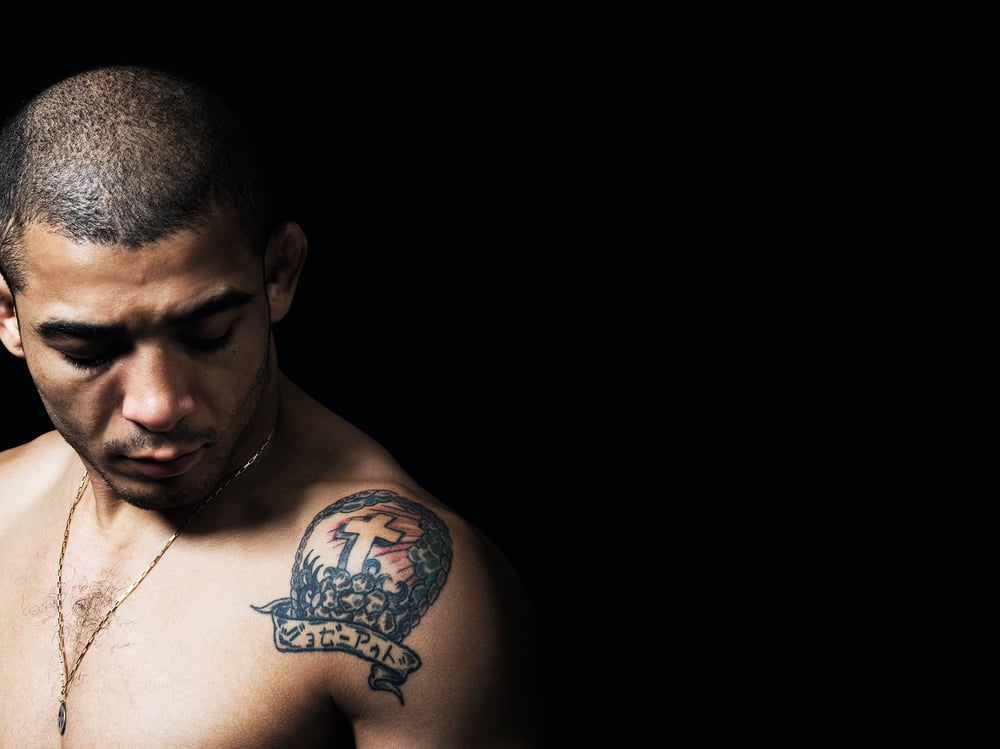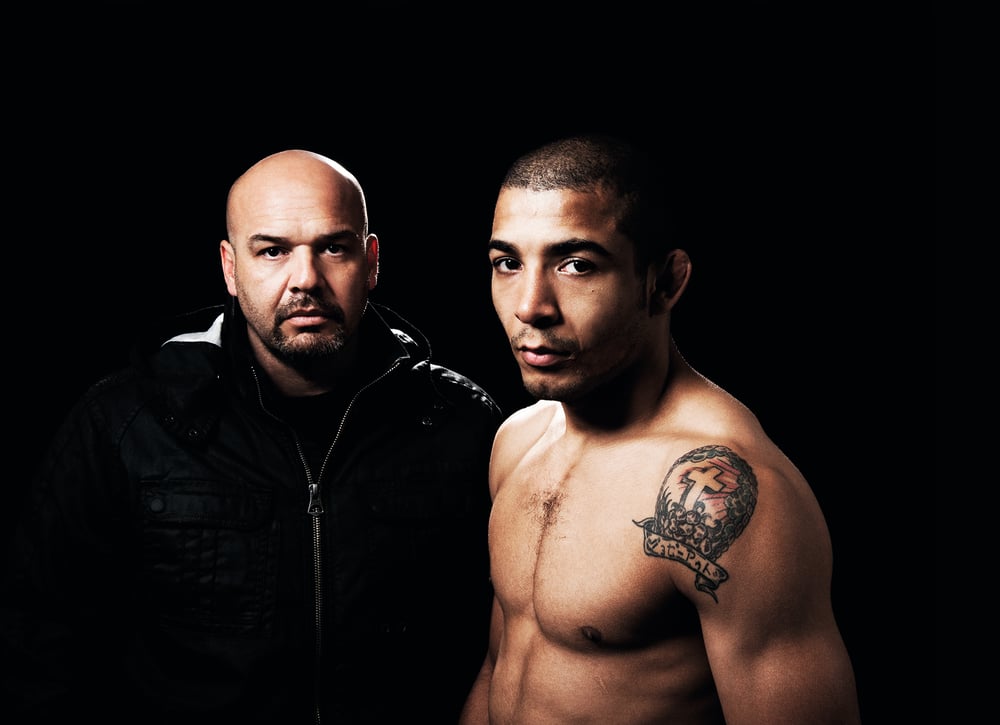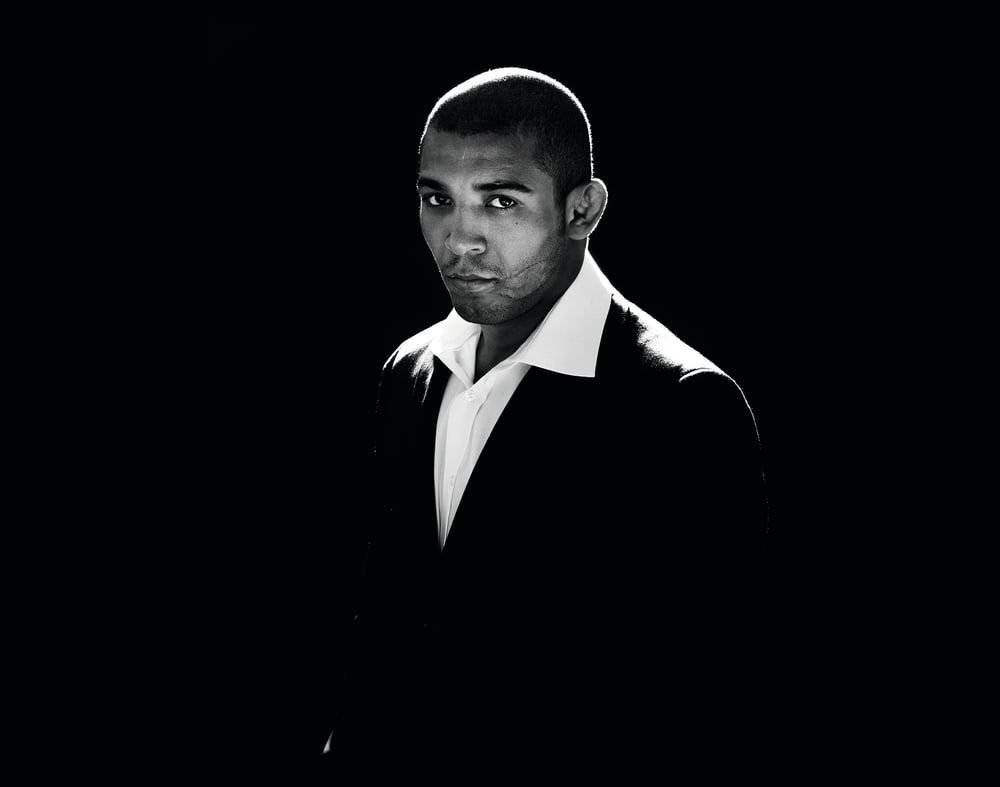
Issue 072
February 2011
Featherweight prince José Aldo stormed the pound-for-pound rankings in 2010 with a lethal cocktail of technical brilliance and ruthless violence. No wonder he’s the ‘Fighter of the Year’.
The Charles 'Mask' Lewis Fighter of the Year
They say fighters are born, not made. José Aldo da Silva Oliveira Júnior fits that aphorism to perfection. JA Jnr’s inception into martial arts tells of a journey from dust and sand to stone and steel. From the Amazon to 21st-century America, the brutality of his art form, shrouded, remarkably, in the romance of a moving love story. It all began with the fighter’s father. They say that we learn what to do, and what not to do, from our parents. Jose Aldo Senior, by his son’s own admission, was affected by years of alcoholism and with it, domestic violence. Inevitably, the young teenage boy’s life was marked. The personal turmoil within the Aldo household broke up Aldo’s parents’ marriage when he was 14 years old. When his mother, Rosilene, left his father after a major disagreement, it created a template for a teen in his formative years. When he discovered his mother had gone Aldo vowed that he would never drink, nor perpetrate any act of violence on a woman: powerful morals which have served him well, and paint the portrait of a young man growing up.
When Aldo met his future wife Vivianne, a purple-belt jiu-jitsu practitioner a couple of years later, in a gym in Rio De Janeiro, he found his soul mate. Vivianne, slightly older than José, became his fighting muse. So the adage goes that behind every great man – is an even greater woman. The developing fighter, living penniless in Rio, sleeping on mats at night and cleaning the gym for his keep, found a bedrock of support in Vivianne, who many insist is the secret behind his transformation from wide-eyed teenager to becoming a man, and one of the most feared fighters in MMA. Indeed, an apartment is currently being built for them in Brazil while the fighter seeks his fame and fortune in the Octagons of the USA.
He is still only 24, yet José Aldo Júnior has shaped a blend of skills he has learned in capoeira, soccer, and Brazilian variants of Muay Thai and jiu-jitsu into a unique and dramatic fighting style with vicious strikes. It’s both emphatic and entertaining, rounded and compelling. Such adventure in MMA has brought him global fame, and the title of Fighters Only World Mixed Martial Arts Awards ‘Fighter of the Year’ in 2010. Aldo was recognized as such at a gala ceremony in Las Vegas on December 1st. If the fans have voted him leading fighter of 2010, his profile is only likely to rocket skywards in 2011 with the elision of World Extreme Cagefighting (WEC), where he fought until recently as featherweight champion, and the Ultimate Fighting Championship, wherein he already wears the promotion’s first ever belt for the 145lb weight class. (He was the fourth - and final – fighter in the history of the WEC to hold the featherweight crown, after Urijah Faber, Mike Brown and Cole Escovedo.) Aldo has a cult following developed from his time in WEC, but there are those who believe his skills may be transferable up through the weight divisions. Lightweight, certainly, is within reach. But just as some of the fighters from Japanese promotion Pride have not fared so well in the UFC, it remains to be seen whether Aldo can scale its heights. Those around him suggest that he is the real deal. It speaks volumes for his reputation that the UFC hierarchy were happy to place the UFC featherweight crown upon him as the first and current UFC featherweight champion. No fist yet raised, but his arm aloft.

But let us rewind, and go back to the very beginning, in Manaus, in the Amazonas region. Aldo grew up in this city in the north of Brazil which has spawned several world-champion BJJ black belts, mixed martial artists and submission grapplers – Wallid Ismail, Saulo Ribeiro, Alexandre Ribeiro, Ronaldo Souza and Bibiano Fernandes. Aldo explains, through a translator, Derek Kronig Lee, from noted manager Ed Soares’ Tough Media: “Yes, there is a very strong tradition of jiu-jitsu in Manaus. In fact, my first memories of sport growing up there are of playing soccer, and they really are great memories. I was pretty good at capoeira and jiu-jitsu – but I was also very good at soccer. When I was a small boy the great hero of Brazilian football was Romario, from the World Cup, and all the kids wanted to be him. But my greatest soccer hero was Diego Maradona.” There are those who say Aldo had the skills and athleticism to make it as a soccer player. Instead it was the fight game which gradually drew him in. He insists his path to the present day was not by design, but simply happened. “It all just gradually came together and fell into place. I trained in jiu-jitsu like many other people nearby in a club, and I made a great number of friends. We all used to train together, and I just progressed really. When MMA turned into a sport, I started to train in it and I loved it and I just found my heart was in it. The rest has been down to hard work and dedication.”
He tells Fighters Only about his background: “I grew up in Manaus, in the Amazon, in the north of Brazil. It was an industrial area, in a humble family.” The story of the scar on the left side of his face is well-documented, but he confirms that as a child, it occurred when his sisters rolled him into a barbecue pit. “It was an accident, and no, my sisters didn’t bully me,” he jokes. “We didn’t have a lot of money. My father was a stonemason and my mother worked in the industry there. I had two sisters, older than me. But we did not want for much. I helped my father, I learned some of the skills of stonemasonry, but deep inside me, I had a dream that I would be a soccer player, and that if it didn’t work out, I’d become a stonemason like him. My life took another route, but in a way my dream has come true, and I am the first person in my family to become a professional sportsman.”
What Aldo has, akin to many other Brazilians in MMA, is a humility which is tangible. I ask him about that, and he replies: “Maybe it is because as Brazilians we have all struggled to get to where we are, and when we go to fight, we leave it all in the ring. Brazil is really a Third World country and you see a lot of misery and poverty when you are growing up. Even if you reach a certain level, you do not lose those memories.” He fought in his first professional MMA fight, aged 17, in EcoFight 1. Fellow countryman and debutant Mário Bigola was dispatched by a head kick eighteen seconds into the first round. Bigola has not been seen in MMA since. It was an early sign of Aldo’s dangerous ability to be a wrecking machine. The carnage continued. He stopped fellow Brazilian Hudson Rocha in his second fight for Shooto Brazil, waved off by doctor stoppage at the end of the first round. Rocha's cut over the left eye was caused by a flying knee, followed up with a barrage of punches for good measure. People were taking notice. His next sequence of fights was typified by brutal ‘soccer kicks’, as Aldo made strides in his new-found profession.

Aged 19, in 2005, he traveled to England, where he fought Phil Harris, in Portsmouth, and Micky Young at FX3: Battle of Britain, defeating Young in the first round by TKO (punches). Aldo recalls his time in the UK: “It was the first time I had been out of Brazil. I had two fights in the UK, over the course of a month. I was supposed to have a third fight but it did not materialize. I liked being in England. I watched Chelsea play soccer, on TV, and I became a fan. Two things about England – no, three. It was cold, I’d like to fight there again and I’d like to go to Stamford Bridge to see Chelsea play.” He is also a fanatical supporter of Brazilian team Clube de Regatas do Flamengo. “Whenever I am not training, I am watching soccer,” he says.
It was on his return to Brazil that he suffered his only career loss, against Luta Livre black-belt Luciano Azevedo at Jungle Fight 5. In spite of an excellent first round, in which he dominated winning most of the exchanges with solid combinations and leg kicks, nullifying Azevedo's takedown attempts, he was submitted by rear-naked choke three minutes 37 seconds into round two. The loss was not only Aldo's first as a professional, but the only defeat he’s suffered in his career so far. It was the first time he had tasted defeat. “I learned a lot that night.” It is obvious from his few words on the matter that he despises losing. Aldo then rebounded with three victories, all by decision, before announcing himself on a bigger stage, making his debut in the World Extreme Cagefighting organization in Sacramento, against Alexandre Franca Nogueira in June 2008. He had finally reached ‘the big time’. He won this first fight, and indeed his next three, by KO or TKO. Yet it was the brutal and dramatic manner of victory in his contest at WEC 41 against the redoubtable Cub Swanson, with a double flying knee eight seconds into the first round, which marked him out as a fan favorite and a special exponent of mixed martial arts. After that triumph, supporters and the MMA media began to rave about the new wunderkind.

He did not disappoint thereafter. At WEC 44, Aldo won the WEC featherweight championship title against Mike Brown, in November 2009, by TKO in the second round. It earned Aldo 'fighter of the year' accolades in 2009 from both MMA Live and Sherdog.com. A star was born. So where did he learn such great skills? “It is really all down to strategy. We study the opponents and the way I fight is dictated by a game plan. It is quite deliberate, not instinctive. It is all about strategy and how we go about putting into practice what I have done in training. I have to give great thanks for the results of my kicking game to Pedro Rizzo, who helped me in the way he worked with me on the heavy bag to get my kicks and my legs stronger. And really, as for my striking style, I think it grew out of wanting to be different. All the guys in my team were really well known for their jiu-jitsu but I wanted to be a striker and give something different.” But there were testing moments that he will never forget. “The hardest time in my career was when I was living out of the gym, in Rio. I had no support, no money… they were tough times.” It was then that he met Vivianne, and became a member of team Nova Uniao. He has not looked back since: “Thank God, I am in a position where I can now help my family and I will continue helping them.”
With Aldo’s star in ascendance, feverish excitement greeted his matchup against former title holder Urijah Faber, one of the most high-profile, and indeed, popular fighters in MMA, last year. With brutal ease, he won a lopsided decision in April 2010 at WEC 48, with scores of 49-45, 49-45, and 50-45 on the judges’ cards. Aldo fired off a non-stop salvo of leg and body kicks to nullify Faber’s skills, eviscerating his rival and sending him to the canvas with several of the blows. Few had anticipated Aldo would be so dominant. The fourth round was a massacre, Aldo trapping Faber in the crucifix, reining down punches and elbows on his rival. Faber finished with his honor intact, but had been taken through the mill. Faber’s only consolation was that it was the first time Aldo had been taken five rounds in the WEC. There were major concerns for Faber’s leg afterward. “It’s just a giant hematoma, you know, from like right here to my hip all the way down to my knee and so it’s about three times the size of my other leg, so you can’t really bend it or walk very well,” ‘The California Kid’ said afterward. There were tests done on Faber’s limb to check that it wasn't permanently damaged. Faber said of his nemesis. “Jose Aldo is a very great champion, he’s a respectable guy, not only in his skill level but the way he presents himself. It’s great to have a guy like that as our champion instead of some of these meatheads that are out there.”
Aldo pauses to talk of a few highlights. “The best moment of my career so far is definitely winning the WEC featherweight title, beating Mike Brown. It was such a brilliant moment it is so hard to find the words to describe it. And of course, my worst moment was losing my only fight.” When UFC president Dana White announced on October 28, 2010 that the WEC, already owned by UFC parent company Zuffa LLC was to merge with the UFC, Aldo was named as the inaugural UFC Featherweight Champion, even receiving the belt 22 days later. “I was delighted, it was a brilliant moment for me,” Aldo says. His first defense was announced for UFC 125 against Josh Grispi, but the incumbent champion was forced to withdraw after suffering a neck injury three days after receiving his UFC belt. But Aldo will not rest on his laurels. “I will only get better. I was ecstatic when the merger with the UFC was made. It is a thrill to be able to fight in the UFC. When I found out I was going to be given the belt, it was unreal. I’ll never forget that time when I had no money. It has marked me, stayed with me, and I will remember it for the rest of my life. It is also part of the motivation which helps me stay dedicated to training.”

The $64 million question for many fans is where Aldo sits in the pound-for-pound rankings. 19 professional fights, 33% by KO. One loss. Without question, he has proved himself to be an MMA phenomenon. He has been voted as fighter of the year, but has he yet earned any right to the number one pound-for-pound strap? Let’s take a closer look. By defeating Manny Gamburyan, Aldo recorded his eighth straight win in the WEC, and it was his seventh stoppage win in those eight fights. His first and only loss was almost five years ago. There is no question that he is the world’s leading 145lb fighter.
Dana White, the CEO of the UFC, believes that Anderson Silva still holds the pound-for-pound mantle, and you would have to put Georges St Pierre high in that mix, too. My own thinking is that, at present, Aldo sits at number three. White sees Aldo “as the potential future pound-for-pound king.” The UFC remains the proving ground for Aldo, and he probably needs a lengthy winning streak in the UFC to do exactly that. He may even have to go up to lightweight and continue to show his skills to take the pound-for-pound crown. Aldo dominated Swanson, Brown, Faber, and Gamburyan, yet Silva holds the record for the most consecutive wins in the UFC, and the most consecutive championship defenses, with seven victories at middleweight. Ten of those 12 wins have come by stoppage. The debate will rage, but so will Aldo as he progresses in the UFC Octagon. How does he feel about being referred to by some people as the pound-for-pound king? He thinks before replying through his manager. “It’s a great feeling, but I’m not going to go around thinking that because I know I have to keep working hard, I know I need to keep improving. For sure there are going to be huge challenges ahead, in every fight, and even more so if I go up in class eventually to lightweight.” It’s no surprise, moreover, that Anderson Silva ranks as his role model with MMA “along with several other Brazilian fighters.”
Aldo, like many within the MMA fraternity, believes the sport needs to reach a wider audience in order for it to be understood. It appears to irk him that there are misconceptions. “I’d like MMA to gain widespread acceptance in the mainstream but for the majority of the population to be turned on to MMA, we need it on network television. I believe that the more people who see it, the more popular it will become because a lot of people still don’t understand it. But I think it will come.” For the legions of new converts to MMA, however, Aldo, all 5’7” of him, is en route, within a year, with his easy manner, humility outside the Octagon, and his vicious methodology within it, to becoming one of the most compelling fighters in the sport. All he has to do now is go out and keep delivering – in the UFC. 2011 could have Aldo’s name stamped all over it.










